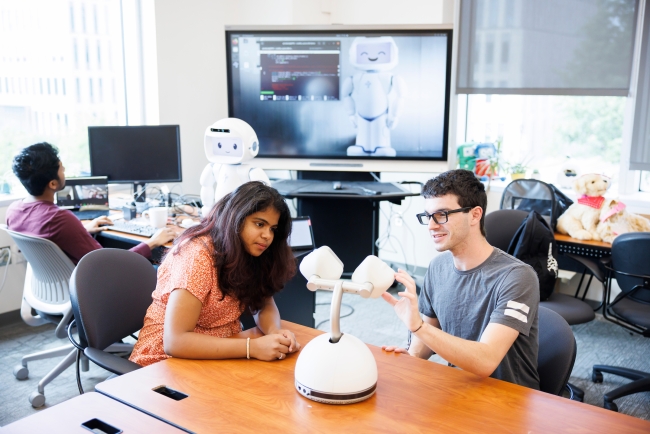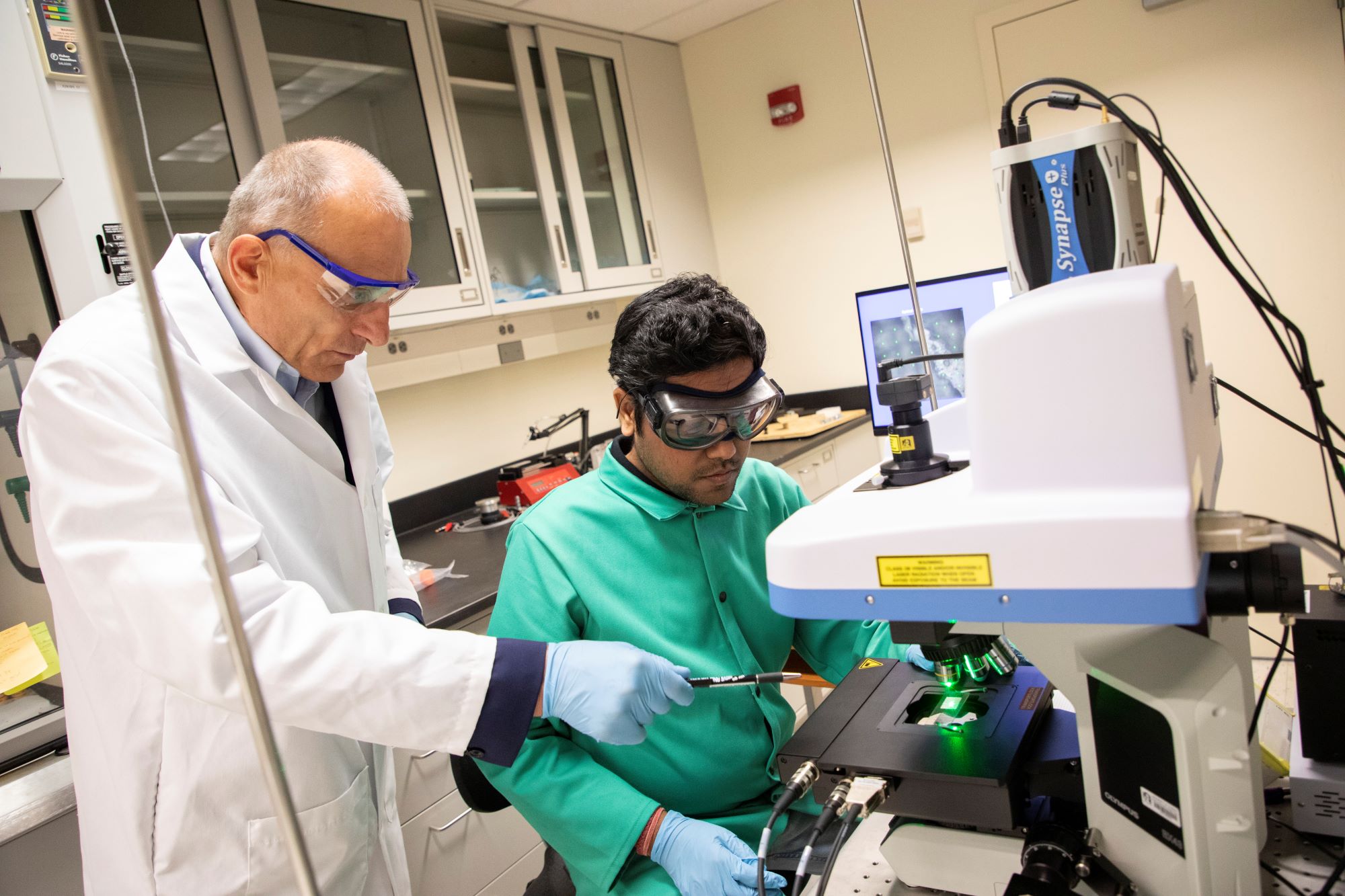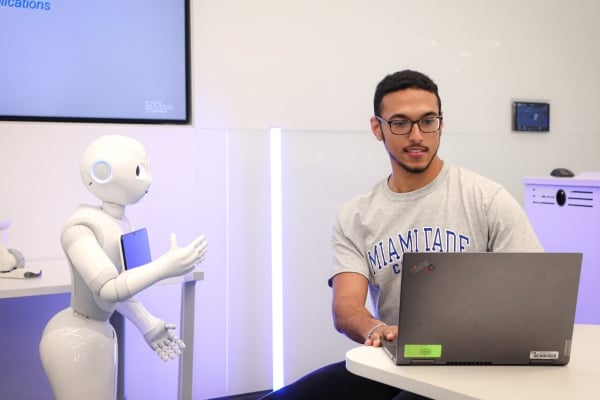You have /5 articles left.
Sign up for a free account or log in.

Students at Indiana University Bloomington’s Luddy School of Informatics, Computing, and Engineering.
IU Bloomington Luddy School of Informatics, Computing, and Engineering
The University at Albany’s $200 million AI plans. A $60 million donation to boost artificial intelligence work at Indiana University at Bloomington. Miami Dade College spending $5 million each for AI centers on two campuses.
Higher ed funding—and a lot of it—is flowing into AI as institutions make big bets that artificial intelligence will be as universal and disruptive as the internet. Institutions across the country are spending vast sums, hiring dozens of faculty and erecting large-scale AI-focused centers.
But even as colleges and universities boldly dive into the AI deep end, industry experts and analysts are urging caution and thoughtful approaches, both for institutions rushing ahead and those at risk of being left on the sidelines.
“It’s risky not to study it,” said Darrell West, a senior fellow at the Brookings Institute. “AI is going to be an important part of everyone’s life … It’s a matter of time before it becomes the mainstream; we’re years from it happening, but there won’t be a higher ed where AI won’t be incorporated.”
There is broad agreement that acting now is the right move, akin to Carnegie Mellon leaning into internet adoption in the 1990s and cementing its status as a top-tier, innovative institution. There is also awareness that failure to innovate is not an option.
“Public trust is going down in institutions. You have the enrollment cliff, the student loan crisis and on and on,” said Roy Mathew, who leads higher education consulting at Deloitte. “So higher education, finally, has woken up to say the status quo is not an option anymore.”
However, experts say, there have to be guardrails around AI investments, from the spending and hiring to the facility construction and course development.
“You can’t go from zero to AI,” Mathew said. “There’s a lot of groundwork that has to be there.”
AI: Fad or the Future?
Despite the recent explosion in public awareness, artificial intelligence is not new—the technology has been evolving for years, and some researchers, including Indiana University’s David Crandell, have spent their entire adult lives studying it.
“A lot of the public thinks AI was invented last November, but it’s … stuff that’s been around for decades,” Crandell, director of the Luddy Artificial Intelligence Center, said.
This also isn’t the first time universities have embraced trendy new technologies. Some have been winners while others have delivered less than promising results.
The internet percolated for decades in military and academic circles before bursting on the public scene with the dawn of websites and an array of consumer applications in the 1990s. Later, in the 2010s, massive online open courses, or MOOCs, led to innovation but largely failed on the promise to expand education access across the world.
AI is more like the internet, with lasting power from broad reach beyond academia, analysts say.
“With MOOCs and similar trends, they were very specific to higher education and you could live without it—it was nice to have, but with all the trends, it was an alternative to a mainstream model,” West of Brookings said. “When AI is becoming the mainstream option for everything we do in life, it’s going to be extremely difficult for higher ed to sit it out.”
Flavors of Higher Ed AI: Takers, Shapers and Makers
Industry experts agree that if institutions are to adopt and embrace AI, they need to do it in a way that works for them, such as Miami Dade, a community college, putting resources toward workforce development or an R-1 university like the University of California, Berkeley, focusing on research.
“We think the doubling down makes a ton of sense, but what they need to figure out is doing it in a unique way, in a way they can compete,” said Saurabh Sanghvi, a leader of education and economic development work at McKinsey.
“It’ll be very hard to compete with the Googles of the world [making AI tools],” he said. “The unique angle is how can universities play more of a role in ethical use cases and responsibilities.”
Many institutions funding AI work say multidisciplinary approaches will provide a better landing for their investments, as opposed to investing solely in the STEM side.
“Do we all want to replicate what MIT is doing? Every university has to identify what are the strengths it can have and be strategic in the investments they make,” said Joanna Mirecki Millunchick, dean of Indiana University’s Luddy School. She said that needs to happen within individual universities and within departments.
The University at Albany’s “AI Plus” initiative, for example, is researching and embedding the technology across its institution, from philosophy to weather prediction.

A University at Albany professor and biochemistry student utilizing AI to test saliva and blood for preclinical signs of Alzheimer’s disease.
University at Albany
The broad reach is a way to assuage concerns, according to University at Albany president Havidán Rodriguez.
“You’ll always have some concerns brought up of, ‘What are the investments you’re making, where is this coming from, will it be sustainable, is it another fad that will disappear,” he said. “And we’re systematically addressing these questions. The beauty of doing it here is doing it across the colleges and schools, not just one.”
McKinsey categorizes universities in three archetypes when it comes to AI adoption, Sanghvi said. There are “takers” using existing software solutions, “shapers” tailoring existing solutions for their institution and “makers” building their own AI.
“The way we’ve said this is, moving forward, you need to do a flavor of each,” he said. “It’s something universities need to understand, which things they can fit into those categories. The reality is if you want to be a maker or even a shaper, the amount of investment is so much it will be difficult to keep pace with the industry.”
Keeping Up With the AI Race
Higher education institutions have realized the potential gold mine of AI talent creation.
“I think you see a lot of universities realize that and say, ‘If we can build a center to train students in the skill, there will be a lot of employers coming to us to recruit’—and that’s a really good thing,” Mathew said.
The massive need has caused universities—which are notoriously slow with adoption—to disregard typical bureaucracy and implement programming sooner rather than later.

A student at Miami Dade College, which has invested more than $10 million into artificial intelligence.
Miami Dade College
“We felt there was a workforce need, and that’s our thought process in developing a program, to meet the workforce needs and be innovative in the way we do it,” said Madeline Pumariega, president of Miami Dade College. The college put $5 million into each of two AI centers located on different campuses. “We have to move this fast, to be responsive to the workforce and responsive to the industries’ needs.”
It’s a move others will have to replicate if they hope to stand out, according to McKinsey’s Sanghvi.
“The main thing we’ve been telling universities is ‘You’re not behind but will have to figure out courses at a much faster cycle than you have before,’” he said. “If we take another five to 10 years to catch up to what industries are demanding, students may find themselves turning toward boot camps.”
The speed is buoyed by a growing number of private and state investments, allowing institutions a safety net with their AI investments.
The University at Albany received $75 million for its initiative from the state of New York, funding that will go toward hiring and building a “supercomputing cluster” that focuses on curriculum change, research and education. However, Rodriguez, the university’s president, said the institution is working to generate funding and sees the investment reaching $200 million.
At Miami Dade, the college revamped existing spaces for its two AI centers with funding from philanthropy and state and federal grants.

IU Bloomington Luddy School of Informatics, Computing, and Engineering
IU Bloomington Luddy School of Informatics, Computing, and Engineering
Indiana University at Bloomington received $60 million from Fred Luddy, with $22.8 million of that going toward the construction of the Luddy School of Informatics, Computing, and Engineering. The remainder was earmarked for hiring, scholarships, faculty chairs and support and fellowships.
Other academia heavy hitters, including the U.S. Department of Labor and the National Science Foundation, are providing resources. The latter gave $140 million across seven institutions in May, tasking each university with a specific AI angle to study, including impacts on cybersecurity, agriculture and decision-making.
“AI has emerged in the social consciousness because we don’t know what the future holds and this version of AI will settle down, occupy a lane and we’ll continue to invest in it and research it,” said Mirecki Millunchick of IU’s Luddy School. “And yes, something else will rise to the common collectiveness, but that doesn’t mean we’ll pivot away from it. Universities are super-conservative groups; we started investing in it decades ago and we’ll continue for decades to come regardless.”
Higher Ed’s Next AI Steps
Deloitte’s Mathew said he believes the first step for many institutions is undergoing an AI fluency lab, which spells out the potential and uses of AI.
“We’re in such early days—if you sit out the next year or two, you’re not missing much; the tools are evolving; the use cases are being piloted,” he said. “However, what I think every university needs to do is raise their fluency and awareness of what AI is.”
And beyond laying the groundwork in AI research and hiring, universities should be utilizing these new tools to boost efficiency within their own walls.
“The focus should be more about supporting the operations of a university, so thinking how to use AI for marketing, admissions, student services and all the back-office functions and a lot of solutions that can exist at greater scales,” Sanghvi said. “Universities have been slower in adopting that use case.”
But through it all, Richard Garrett, chief research officer at Eduventures, a higher education–focused research firm, said universities need to keep a level head and not fall into the AI hype.
“Yes, institutions should factor this into their areas of focus but do so in a skeptical, inquiring way, not getting carried away with this or that survey,” he said. “Being a university means they need to push back on overly quick conclusions, which can cause unintended consequences; if universities don’t do that, I’m not sure who is going to do that.”









